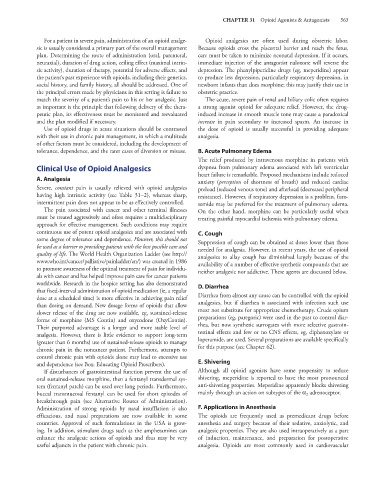Page 577 - Basic _ Clinical Pharmacology ( PDFDrive )
P. 577
CHAPTER 31 Opioid Agonists & Antagonists 563
For a patient in severe pain, administration of an opioid analge- Opioid analgesics are often used during obstetric labor.
sic is usually considered a primary part of the overall management Because opioids cross the placental barrier and reach the fetus,
plan. Determining the route of administration (oral, parenteral, care must be taken to minimize neonatal depression. If it occurs,
neuraxial), duration of drug action, ceiling effect (maximal intrin- immediate injection of the antagonist naloxone will reverse the
sic activity), duration of therapy, potential for adverse effects, and depression. The phenylpiperidine drugs (eg, meperidine) appear
the patient’s past experience with opioids, including their genetics, to produce less depression, particularly respiratory depression, in
social history, and family history, all should be addressed. One of newborn infants than does morphine; this may justify their use in
the principal errors made by physicians in this setting is failure to obstetric practice.
match the severity of a patient’s pain to his or her analgesic. Just The acute, severe pain of renal and biliary colic often requires
as important is the principle that following delivery of the thera- a strong agonist opioid for adequate relief. However, the drug-
peutic plan, its effectiveness must be monitored and reevaluated induced increase in smooth muscle tone may cause a paradoxical
and the plan modified if necessary. increase in pain secondary to increased spasm. An increase in
Use of opioid drugs in acute situations should be contrasted the dose of opioid is usually successful in providing adequate
with their use in chronic pain management, in which a multitude analgesia.
of other factors must be considered, including the development of
tolerance, dependence, and the rarer cases of diversion or misuse. B. Acute Pulmonary Edema
The relief produced by intravenous morphine in patients with
Clinical Use of Opioid Analgesics dyspnea from pulmonary edema associated with left ventricular
heart failure is remarkable. Proposed mechanisms include reduced
A. Analgesia anxiety (perception of shortness of breath) and reduced cardiac
Severe, constant pain is usually relieved with opioid analgesics preload (reduced venous tone) and afterload (decreased peripheral
having high intrinsic activity (see Table 31–2), whereas sharp, resistance). However, if respiratory depression is a problem, furo-
intermittent pain does not appear to be as effectively controlled. semide may be preferred for the treatment of pulmonary edema.
The pain associated with cancer and other terminal illnesses On the other hand, morphine can be particularly useful when
must be treated aggressively and often requires a multidisciplinary treating painful myocardial ischemia with pulmonary edema.
approach for effective management. Such conditions may require
continuous use of potent opioid analgesics and are associated with C. Cough
some degree of tolerance and dependence. However, this should not Suppression of cough can be obtained at doses lower than those
be used as a barrier to providing patients with the best possible care and needed for analgesia. However, in recent years, the use of opioid
quality of life. The World Health Organization Ladder (see http:// analgesics to allay cough has diminished largely because of the
www.who.int/cancer/palliative/painladder/en/) was created in 1986 availability of a number of effective synthetic compounds that are
to promote awareness of the optimal treatment of pain for individu- neither analgesic nor addictive. These agents are discussed below.
als with cancer and has helped improve pain care for cancer patients
worldwide. Research in the hospice setting has also demonstrated D. Diarrhea
that fixed-interval administration of opioid medication (ie, a regular
dose at a scheduled time) is more effective in achieving pain relief Diarrhea from almost any cause can be controlled with the opioid
than dosing on demand. New dosage forms of opioids that allow analgesics, but if diarrhea is associated with infection such use
slower release of the drug are now available, eg, sustained-release must not substitute for appropriate chemotherapy. Crude opium
forms of morphine (MS Contin) and oxycodone (OxyContin). preparations (eg, paregoric) were used in the past to control diar-
Their purported advantage is a longer and more stable level of rhea, but now synthetic surrogates with more selective gastroin-
analgesia. However, there is little evidence to support long-term testinal effects and few or no CNS effects, eg, diphenoxylate or
(greater than 6 months) use of sustained-release opioids to manage loperamide, are used. Several preparations are available specifically
chronic pain in the noncancer patient. Furthermore, attempts to for this purpose (see Chapter 62).
control chronic pain with opioids alone may lead to excessive use
and dependence (see Box: Educating Opioid Prescribers). E. Shivering
If disturbances of gastrointestinal function prevent the use of Although all opioid agonists have some propensity to reduce
oral sustained-release morphine, then a fentanyl transdermal sys- shivering, meperidine is reported to have the most pronounced
tem (fentanyl patch) can be used over long periods. Furthermore, anti-shivering properties. Meperidine apparently blocks shivering
buccal transmucosal fentanyl can be used for short episodes of mainly through an action on subtypes of the α adrenoceptor.
2
breakthrough pain (see Alternative Routes of Administration).
Administration of strong opioids by nasal insufflation is also F. Applications in Anesthesia
efficacious, and nasal preparations are now available in some The opioids are frequently used as premedicant drugs before
countries. Approval of such formulations in the USA is grow- anesthesia and surgery because of their sedative, anxiolytic, and
ing. In addition, stimulant drugs such as the amphetamines can analgesic properties. They are also used intraoperatively as a part
enhance the analgesic actions of opioids and thus may be very of induction, maintenance, and preparation for postoperative
useful adjuncts in the patient with chronic pain. analgesia. Opioids are most commonly used in cardiovascular

